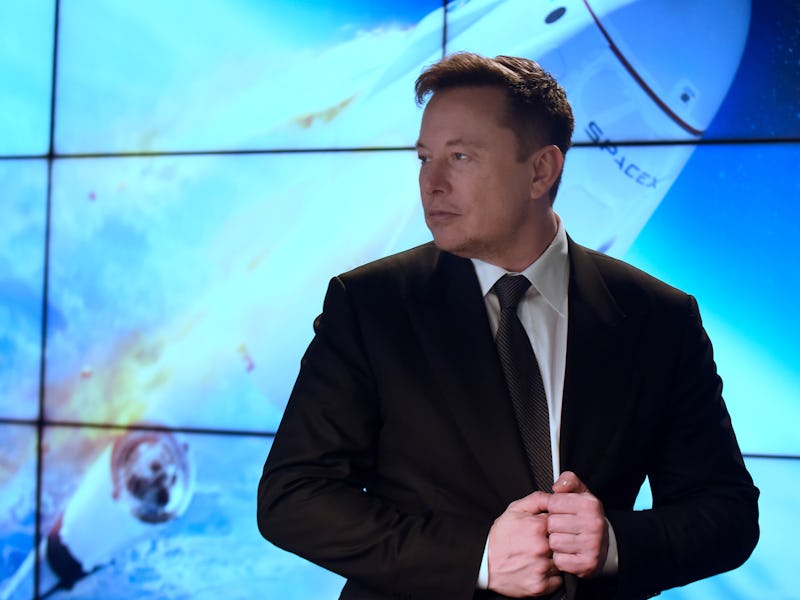Elon Musk responds to claim he needs 10,000 missiles to terraform Mars
The SpaceX CEO is not too concerned about reports that the firm would need a huge amount of missiles.

Humanity may need more than 10,000 missiles to nuke Mars and transform the planet into something more hospitable to humans. But Elon Musk, the tech entrepreneur that's spoken before about his wish to terraform Mars, suggested Sunday that the huge stock of weapons needed for the project would be no big deal.
Input: What's wrong with Elon Musk?
Musk has previously described the prospect of using weapons to release carbon dioxide stored inside Martian terrain, which would enable humans to move around the planet with simpler equipment. Alexander Bloshenko, executive director for science and long-term programs for Russian space agency Roscosmos, claimed in an interview with Russian news agency TASS last week that it would take over 10,000 nuclear warheads to bring the plan to life:
"If briefly analyzed, certain plans put forward by SpaceX simply cannot be implemented taking into account the short-term technological developments. For example, for a thermonuclear explosion on Mars’ pole, one of the plans of SpaceX, to have tangible results, more than 10,000 launches of missiles that can carry the largest payloads and are being developed now are needed."
Bloshenko concluded by stating that humanity cannot influence in a tangible way the atmosphere on Mars or Venus. But in response to the article, shared by SpaceNews writer Jeff Foust with the words "headline of the day," Musk seemed to suggest that it was not a show-stopping figure.
"No problem," Musk wrote on his Twitter page Sunday.
Musk's Twitter post.
It's not the first time Musk has raised the prospect of terraforming Mars. Back in August 2019, he released a t-shirt emblazoned with the phrase "nuke Mars." SpaceX, which is currently building a rocket designed to send humans to Mars and start a city, also has its eyes on the bigger prize – the firm's lobby in California hosts an artists' impression of a terraformed Mars.
A terraformed Mars image in the SpaceX headquarters.
The idea would involve using a continuous stream of low-fallout explosions, creating something akin to an artificial sun above each pole without making it radioactive. This would be used to heat the ice reserves and release carbon dioxide. These reserves are theorized to be left over from when Mars was warmer and wetter around four billion years ago, as opposed to now where temperatures are around minus 80 degrees Fahrenheit. With these gas reserves unlocked, humans would be free to move around the planet's surface with just a breathing apparatus.
Musk is not the first person to suggest the idea. Research from 2015 published in the journal Geophysical Research Letter suggested there could be up to 150 billion cubic meters of ice on the planet. And research from 1993 by Robert Zubrin and Christopher MacKay claimed there could be enough carbon dioxide on the planet to create an atmosphere with pressure between 300 and 600 millibars. Earth's atmosphere, for comparison, is around 1,000 millibars.
It wouldn't be Musk's first attempt to deal with weaponry. Back in 2001, Musk worked with a team to try to buy intercontinental ballistic missiles from Russia to send mice into space. Their contacts wanted $21 million per rocket, an extortionate sum that left Musk thinking they could build their own rockets. SpaceX was founded the following year.
The Inverse analysis – Musk's plan would be a long-term prospect, a future idea that could expand on the initial plans to start a Mars base and establish an extraterrestrial outpost for humanity. But some researchers have questioned whether the planet has enough carbon dioxide. Bruce Jakosky and Christopher S. Edwards published a paper in the journal Nature Astronomy in July 2018 that claimed the polar ice caps would only provide enough carbon dioxide for around 15 millibars of atmospheric pressure.
Musk responded to Jakosky and Edwards' research by stating that there is "a massive amount of CO2 on Mars adsorbed into soil that’d be released upon heating," adding that "with enough energy via artificial or natural (sun) fusion, you can terraform almost any large, rocky body."
As work continues on the Starship rocket designed to send the first humans to Mars, SpaceX will need to overcome some more near-term challenges before it could consider trying to bring the image in its lobby to life. The Starship's first full-size prototype launch, expected sometime this year, could be a landmark event in the race to get humans on Mars.
This article was originally published on